'˜Cutting edge' anti-terror barriers to be erected in Capital


City council officials have revealed moves to invest in new “hostile mitigation barriers” which would become regular fixtures on the likes of the Royal Mile, George Street, The Mound and St Andrew Square.
The local authority is expected to invest in a series of “flexible gates” which can be moved around the city depending on which major events are being staged. It is understood that they would provide the city with the first bespoke crowd protection system in the UK.
Advertisement
Hide AdAdvertisement
Hide AdExtensive tests on the latest technology to deter would-be terrorists have already been carried out at one of the UK’s main defence testing centres.
The council’s plans have been drawn up as part of an ongoing review of “counter-terrorism measures for the whole of the city centre”, the findings of which are due to be published in the summer. The new system would allow temporary barriers which were installed in key locations around the city centre before last year’s summer festivals to be removed. The UK government is footing the bill for the deployment of part of the “National Barrier Asset”, a system of gates, portals and barriers which are designed to prevent hostile vehicle attacks on busy locations. They were installed in the wake of last year’s terror attacks in Manchester and London.
The Edinburgh Festival Fringe Society, which runs street theatre arenas on the Royal Mile and The Mound, has previously admitted that the event has been a “soft target” for terrorists before barriers were introduced. Organisers have also disclosed that some performers considered pulling out of the event last year due to security concerns.
It emerged just days before last year’s Fringe, which can attract more than 50,000 people to the High Street every day during August, that the yellow barriers would be introduced at key points around the city centre. At the time police chiefs said the measures were intended to help keep people safe in the event of “vehicle as a weapon attacks”.
Advertisement
Hide AdAdvertisement
Hide AdThe new system has been developed in the wake of extensive talks with Police Scotland officials and other security experts about what measures are necessary for the city centre in the medium-long term, as well as recent tests at the Motor Industry Research Association’s base in Nuneaton, in Sussex.
A report for the city council states: “Initial tests were very positive, slowing up vehicles and creating noise to alert any people in the area, and ideas for improvement and further testing have been discussed and are likely to be implemented.
“This will provide a number of fully flexible gates which can be deployed by council resources and which can provide a known level of protection to events in the city. Edinburgh is the only local authority that has devised and developed its own protection system.
“The more robust National Barrier Asset (NBA) is still in place in the six key locations around the Royal Mile, principally to protect the Fringe and the Tattoo, as well as any other events or marches on the High Street, and has a year’s deployment period left.”
Advertisement
Hide AdAdvertisement
Hide AdDonald Wilson, the council’s culture convener, said: “As a capital city and a major destination for festivals and events, appropriate measures are put in place every year to ensure the security of our crowded places. We were the first council to work with local police to devise and develop our own protection system, which is always reviewed to ensure it is fit for purpose.
“Our officers are now working on a set of flexible and robust security barriers which can be used in different locations throughout the year. This is not in response to any threat, rather it is the council acting proactively in partnership with Police Scotland to enhance the strength and longevity of the temporary barriers we already have available. They are a public safety precaution and we hope they will be viewed as the city continuing to put public safety first.
“Further testing will take place and a report detailing the protection of the city centre will be brought forward to a future meeting of the culture and communities committee.”
Police Scotland says its policing plans for major events are “dynamic and dependent on the security picture at the time.”
Advertisement
Hide AdAdvertisement
Hide AdA spokeswoman said: “We work closely with event organisers to advise on safety in the run up to and during events and provide appropriate police resources when events are taking place. The deployment of the National Barrier Asset and any further barriers is a matter for the council, although we would provide input.”
Security was stepped up across Edinburgh last summer, with bag searches introduced for the first time at many major venues. However they were ruled out as impractical at entrances to the main street theatre arenas on the Royal Mile and The Mound.
Speaking at a major events conference in the autumn, Andy Meldrum, street events manager for the Fringe, said: “After the attacks in Manchester and London in May and June, the security concerns for the Edinburgh Festival were growing and people were scared.
“I had performers and participants considering pulling out because they were fearful that something might happen. Around two weeks before the event was due to happen, somebody somewhere decided Edinburgh needed a more robust security system.
Advertisement
Hide AdAdvertisement
Hide Ad“We also had armed police on patrol for the first time, but they actually became one of the most popular attractions on the Royal Mile. People were going up and taking their photographs and getting selfies taken with them.
“I was actually quite surprised just how easily the public took to that kind of deployment. They very much took it in their stride.”
